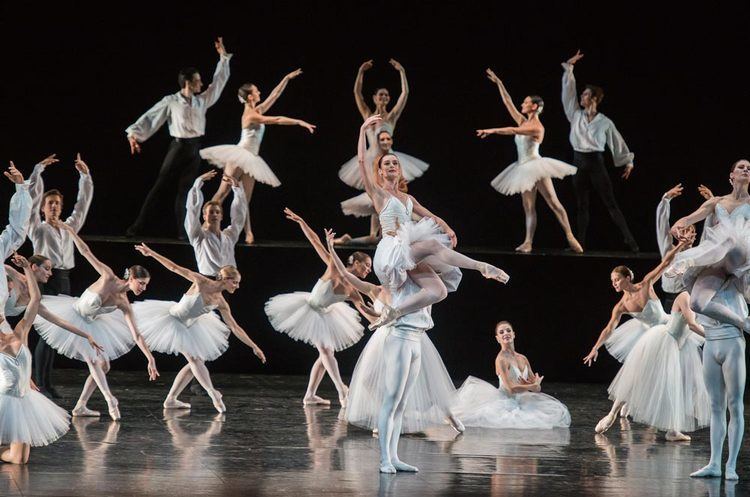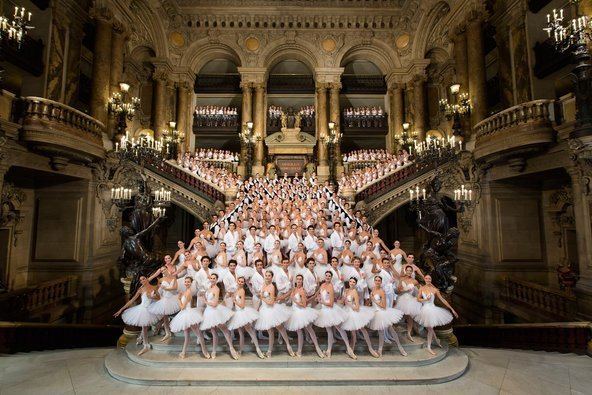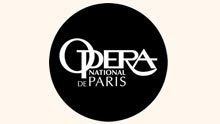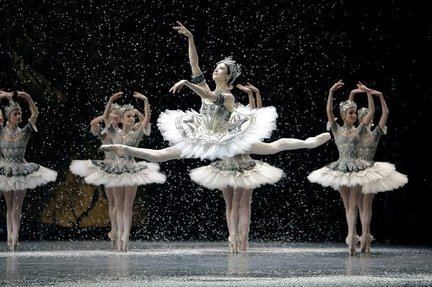Role Ballet company Founded 1669 Name Paris Ballet Founder Louis XIV of France | Website www.operadeparis.fr Year founded 1669 Construction started 1861 Architect Charles Garnier | |
 | ||
Local name Ballet de l'Opera de Paris Previous names Academie d'OperaAcademie Royale de MusiqueAcademie Imperiale de MusiqueTheatre National de l'Opera Awards Laurence Olivier Award for Outstanding Achievement in Dance Similar Palais Garnier, Opera Bastille, Opera Nouvel, Hotel Ritz Paris, Bolshoi Theatre - Moscow Profiles | ||
Paris Opera Ballet: full 'Midsummer Night's Dream' Act II divertissement (Balanchine)
The Paris Opera Ballet (French: "Ballet de l'Opéra national de Paris") is an integral part of the Paris Opera and the oldest national ballet company. Together with the Moscow Bolshoi Ballet and the London Royal Ballet it is regarded as one of the three most preeminent ballet companies in the world.
Contents
- Paris Opera Ballet full Midsummer Nights Dream Act II divertissement Balanchine
- Paris opera ballet robbins millepied balanchine in cinemas 13 18 nov 2015
- Naming
- Background
- Founding and early history
- Later history
- Serge Lifar as ballet director
- Era of Rudolf Nureyev
- Brigitte Lefvre
- Transition
- Aurlie Dupont
- Hierarchy
- Small scandals and the lost generation
- Paris Opera Ballet School
- Choreographers
- Dancers
- References

Since August 2016 the company has been under the direction of Aurélie Dupont, the "Directrice de la Danse".

The ballet company consists of 154 dancers, among them 17 Danseurs Étoiles. The principal dancers give 180 dance performances each year, primarily at the Palais Garnier.

Just as prestigious as the Paris Opera Ballet is its dance school, the Paris Opera Ballet School (French: "École de danse de l'Opéra national de Paris"), considered as the world's best dance school. Its former pupils have won a record of 20 Benois de la Danse awards. The school celebrated its tercentennial in 2013.
The competition for admission to both institutions is extremely fierce. To be admitted there, to pass the annual competitive examinations in May, and to attend at least the final two classes is basically compulsory for dancers entering the Paris Opera Ballet.
As its Ballet School is excellent and graduates many young dancers who are or the most part (95%) French, there are hardly any foreigners in the Paris Opera Ballet Company.
Paris opera ballet robbins millepied balanchine in cinemas 13 18 nov 2015
Naming
The Paris Opera Ballet has always been an integral part of the Paris Opera, which was founded in 1669 as the Académie d'Opéra (Academy of Opera), although theatrical dance did not become an important component of the Paris Opera until 1673, after it was renamed the Académie Royale de Musique (Royal Academy of Music) and placed under the leadership of Jean-Baptiste Lully. The Paris Opera has had many different official names during its long history but since 1994 has been called the Opéra National de Paris (Paris National Opera).
Background
The Paris Opera Ballet had its origins in the earlier dance institutions, traditions and practices of the court of Louis XIV. Of particular importance were the series of comédies-ballets created by Molière with, among others, the choreographers and composers Pierre Beauchamps and Jean-Baptiste Lully. The first was Les Fâcheux in 1661 and the most important, Le Bourgeois gentilhomme in 1670. Many of these were also performed by Molière's company at the public Théâtre du Palais-Royal in Paris, which was later to become the first permanent home of the opera company and the opera ballet.
Also in 1661, Louis XIV had founded the Académie Royale de Danse (Royal Academy of Dance) in an effort "to improve the quality of dance instruction for court entertainments". Members of the academy, as well as the dance teachers who were certified by it, and their students, participated in the creation of the ballets for the court, Molière, and later the opera. In 1680, Beauchamps became the chancellor (director) of the Académie Royale de Danse. Although the Académie Royale de Danse and the Opera were closely connected, the two institutions remained separate, and the former disappeared with the fall of the monarchy in 1789.
Founding and early history
On 28 June 1669, Louis XIV granted a privilege to the poet Pierre Perrin giving him a monopoly to form a separate academy for the performance of opera in French. The first production of the company founded by Perrin, the Académie d'Opéra (Academy of Opera), was Pomone, which was first performed on 3 March 1671 at the Jeu de Paume de la Bouteille and included ballets choreographed by Anthoine des Brosses.
In 1672, Lully purchased Perrin's privilege and also obtained new letters patent limiting the use of musicians and dancers by other French companies. With Anthoine des Brosses and Lully as choreographers and Carlo Vigarani as stage designer, Lully's company, now called the Académie Royale de Musique, produced Lully's first opera, Les fêtes de l'Amour et de Bacchus (a pastorale) in November 1672 at the Jeu de Paume de Béquet. This work consisted primarily of excerpts from Lully's prior court ballets connected with new entrées choreographed by des Brosses. A crucial difference, however, from the previous court ballets was that the members of the court no longer participated, and all of the dancers were professionals.
Lully's next production, Cadmus et Hermione (27 April 1673), the first tragédie lyrique (with a libretto by Philippe Quinault), also premiered at the Jeu de Paume de Béquet and was choreographed by Anthoine des Brosses. Pierre Beauchamps, who had been working with Molière at the Palais-Royal, joined Lully's company in June 1673 (not long after Molière's death), when Lully took over the Palais-Royal theatre, forcing Molière's troupe to move to the Théâtre Guénégaud. Lully and Quinault continued to collaborate on a series of successful productions, in the process creating a new genre of French opera in which dance interludes played an important part in the musical drama. The ballets for these works were created by Beauchamps, des Brosses, and d'Olivet. Jean-Baptiste Dubos explains that Beauchamps and des Brosses were responsible for the ballets ordinaires, while d'Olivet specialized in ballet-pantomime:
Lully paid such great attention to the ballets mentioned here that he engaged for their choreography a 'maître de danse particulier' named d'Olivet. It was he, and not des Brosses or Beauchamps, whom Lully engaged for the 'ballets ordinaires', who composed the ballets of the infernal scenes of Psyché and Alceste. It was also d'Olivet who composed the ballet of the old men in Thesée, of the baneful dreams in Atys, and of the tremblers in Isis. This last was composed solely of pantomimic gestures by men seized with cold, and he did not introduce a single usual dance step into it.
Initially the dancers of the Paris Opera Ballet were all male. Mademoiselle de la Fontaine (1665–1738) became the first professional ballerina when she danced in the premiere of Lully's ballet Le Triomphe de l'Amour on 21 January 1681. Pierre Beauchamps continued to collaborate with Lully at the Paris Opera until Lully's death in 1687.
Later history
The 18th century saw the creation of an associated school, now referred to as the Paris Opera Ballet School (French: École de Danse de l’Opéra de Paris), which opened in 1713. The operas of Rameau, and later Gluck, raised standards for the dancers. Jean-Georges Noverre was a particularly influential ballet master from 1776 to 1781. He created the ballet Les petits riens in 1778 on Mozart's music. Maximilien Gardel was ballet master from 1781, with his brother Pierre Gardel taking over after Maximilien's death in 1787. Pierre Gardel survived the Revolution creating ballets such as La Marseillaise and Offrande à la Liberté. He remained the ballet master until 1820 and continued to work up to 1829.
In 1820, Pierre Gardel was succeeded as ballet master by Jean-Louis Aumer, who was however highly criticized for using too much mime and failing to use choreography which furthered plot or character. In 1821, the company moved to a new house, the Salle Le Peletier, where Romantic ballet was born.
In 1875, the company moved to the Palais Garnier where it continues to perform.
Serge Lifar as ballet director
In 1929, Jacques Rouché invited 24-year-old dancer Serge Lifar to take over the directorship of the Paris Opéra Ballet, which had fallen into decline in the late 19th century.
As ballet master from 1930 to 1944, and from 1947 to 1958, he devoted himself to the restoration of the technical level of the Opéra Ballet, returning it to its place as one of the best companies in the world.
Lifar gave the company a new strength and purpose, initiating the rebirth of ballet in France, and began to create the first of many ballets for that company. During his three decades as director of the Paris Opéra Ballet, Lifar led the company through the turbulent times of World War II and the German occupation of France. Lifar brought the Paris Opéra Ballet to America and performed to full houses at the New York City Center. Audiences were enthusiastic and had great admiration for the company of dancers.
Era of Rudolf Nureyev
In the world of ballet Rudolf Nureyev is regarded as the greatest classical dancer ever and as one of the most preeminent choreographers.
In 1983, Rudolf Nureyev was appointed director of the Paris Opera Ballet, where, as well as directing, he continued to dance and to promote younger dancers.
The top female ballet dancer at that time, if not of all times was Sylvie Guillem who was nominated principal dancer at the age of 19 by Rudolf Nureyev in 1984. They were a mythical dance couple.
The years of Nureyev marked a golden era of the Paris Opera Ballet.
Brigitte Lefèvre
Brigitte Lefèvre, director from 1995 to 2014, with Patrice Bart as maitre de ballet from 1990 to 2011, succeeded to maintain the high standard that Nureyev has set.
Brigitte Lefèvre invited some of the most preeminent choreographers such as William Forsythe, Angelin Preljocaj, Saburo Teshigawara, and John Neumeier.
Transition
There have been turbulent times of the company with Benjamin Millepied, director of the Paris Opera Ballet from Novembre 2014 on who quit on 15 July 2016.
There were two stumbling blocks with Millepied, a French dancer and choreographer, who left France in 1993 at the age of 16, got his main professional education as a dancer and choreographer in the United States and came back to France in 2014 as newly-appointed director of the Paris Opera Ballet.
The one was that Millepied wanted the Paris Opera Ballet dancers to interpret La Bayadère, a classic ballet choreographed by Rudolf Nureyew in 1993, like a contemporary ballet. To achieve this goal he has already hired guest principal dancers to present La Bayadère.
The other stumbling block was that Millepied has actually broken the hierarchy with the "Danseurs Étoiles" dancing the leading roles as he has chosen for the cast of his first contemporary ballet creation "Clear, Loud, Bright, Forward" (the first one in his time as director) out of the 154 danseurs a "dream team" of 16 dancers which he considered to be the fittest to put to practice his ideas and visions (on the programming the dream team was named "United visual artists"). Karl Paquette, principal dancer, saud in an interview that he didn't feel so badly since 6 months. Stéphane Bullion, principal dancer, added that it was clear that things could not be straightened out.
Stéphane Lissner, the Paris Opera director who hired Benjamin Millepied in January 2013 — and who has final authority on decisions about budget, hiring and promotion — said at a news conference at the Palais Garnier on Thursday 4 February 2016 that he had no regrets about that choice.
“He leaves too soon, but others leave too late.” Lissner added, “I think that the two jobs, director of dance and a choreographer who is more and more in demand, not just at the Opera, raised a certain number of questions.”
Aurélie Dupont
Aurélie Dupont took over the direction of the ballet company on 1 August 2016.
Aurélie Dupont was Danseuse Étoile from 1994 to 2015. Aurelie Dupont was the inspiration behind the Cédric Klapisch film about the star, considered the grande dame of the Paris Opera Ballet.
Hierarchy
The hierarchy of the Paris Opera Ballet is very strict. For a dancer it is virtually compulsory to enter first the Paris Opera Ballet School. "You cannot get into the company if you have not done the school" (Mathilde Froustey). The competition for admission to both institutions is extremely fierce as well as the competition for the highest ranks in the ballet company.
More than 90 percent of the candidates don't pass the Ballet School entrance examination, 20 percent of its pupils have to leave at the end of the year failing in the annual competitive examinations ("les concours annuels") in May. Only 5 to 20 percent of the Ballet School graduates are accepted in the Paris Opera Ballet, initially as dancers on trial (the "stagiares")
To become a regular member of the Paris Opera Ballet as "Quadrille" (fifth and lowest rank in the hierarchy) you have to pass the annual competitive examination in November. Promotion to the next rank depends exclusively on success in the following annual competitive examinations ("les concours internes de promotion") in front of a board of judges. To achieve the highest rank as Danseur Étoile (only by nomination) you have to perform in leading roles as "Premier Danseur" for many years before you are nominated due to outstanding excellence and merit.
Small scandals and the lost generation
As the Paris Opera Ballet has a large quantity of first-class French dancers there are hard times for those who have not been promoted to the highest ranks as dancers or have not been appointed afterwards for positions for which they would have been extremely qualified.
Mathilde Froustey, Sujet from 2005 till 2013 left the Paris Opera Ballet in July 2013 and joined the San Francisco Ballet as a principal dancer because there was no chance for her becoming eventually Danseuse étoile (principal dancer) in this company. In November 2014 Benjamin Millepied, a former principal dancer of the New York City Ballet and French, took over the direction of the company and promised a change: "They asked for a change and they will get a change." When Benjamin Millepied nominated for the first (and only) time a "Danseuse étoile", Laura Hecquet was chosen. Laura Hecquet and Mathilde Froustey were described in the press as "the lost generation" of dancers working up the ranks who have become soloist (Sujet) but have been unlucky for years as far as climbing up the last step of the career ladder is concerned.
The Paris Opera Ballet School has churned out some of the most famous dancers of all time, such as Sylvie Guillem and Laurent Hilaire.
Yet Sylvie Guillem, being principal dancer since 1984, left the company in 1989 at the age of 24 because she wanted more freedom, the right to perform with other companies, an arrangement the management of the Paris Opera Ballet declined.
Laurent Hilaire was highly appreciated as principal dancer. After his farewell as a dancer he continued his career in the company attaining in 2011 the second-highest position as "Maitre de ballet associated to the direction". Laurent Hilaire was the favourite of Brigitte Lefèvre, director of the ballet, and Nicolas Joel, director of the Paris Opera at the time. In January 2013 Stéphane Lissner the new director of the Paris Opera (in the hierarchy above the Paris Opera Ballet's director) appointed Benjamin Millepied. Hilaire announced in May 2014 his departure and quit the company in July. The Paris Opera Ballet's new director Benjamin Millepied on his part stayed only two seasons and was followed in August by Aurélie Dupont, who was as Danseuse Ètoile the Grand-dame of the Paris Opera Ballet.
François Alu, Premier Danseur since 2013 and 23 years old, is regarded for his technique particularly stunning jumps and dazzling pirouettes and his dance style as the next principal dancer to be nominated. Now, this isn't amazing news, well-known for at least two years. François Alu was called by the critic Laura Capelle in her review of 10 January 2013 for DanceTabs as "Wunderkind" (child prodigy).
Sylvie Guillem who was nominated Danseuse Étoile even at the age of 19 by Rudolf Nureyev, director of that time, told about Nureyev that he was excellent in this regard thinking of him great anyway. Rudolf Nureyev once said in an interview on Sylvie Guillem: She is so young and she wants to become like me.
Paris Opera Ballet School
The Paris Opera Ballet School (French: "École de danse de l'Opéra national de Paris") is one of the most preeminent in the world. It has six classes for boys and girls separately named "sixième division" to "première division". In 1987, the Paris Opera Ballet School moved from the Palais Garnier where most of the Paris Opera ballets take place to a new building located 10 kilometres west of the centre of Paris in Nanterre. The new dance school building was designed by Christian de Portzamparc. Since 1995 the Paris Opera Ballet School has been a boarding school, Nowadays, from 8 till noon, all pupils attend school classes leading to the obtention of the French "baccalauréat (the bac)", the general qualification for university entrance in France.
Among the dancers of the Paris Opera Ballet, 95 percent have attended the Paris Opera Ballet School. To describe it differently, for a young dancer to be accepted in the Paris Opera Corps de ballet it is virtually obligatory to enter the Paris Opera Ballet School and attend at least the final two classes (deuxième et première division). More than 90 percent of the candidates do not pass the entrance examination. Even some of the dancers who have later become premiers danseurs (first soloists) or danseurs étoiles (principal dancers) of the Paris Opera Ballet passed the entrance examination only on the second attempt or were accepted only as fee-paying pupils.
Choreographers
Choreographers associated with the Paris Opera Ballet and works created for the Paris Opera Ballet are:
Dancers
There are five ranks of dancers in the Paris Opera Ballet, from highest to lowest they are: Danseur Étoile, premier danseur, sujet, coryphée, and quadrille.
